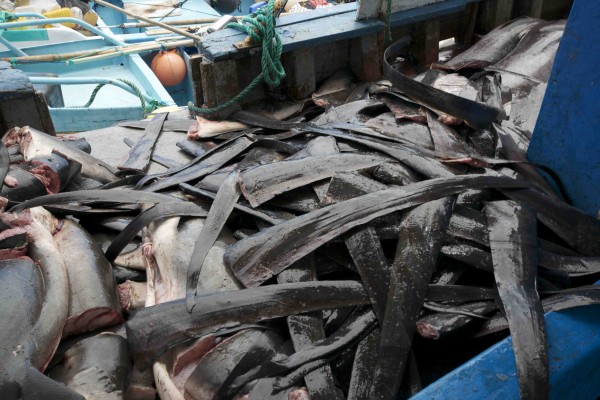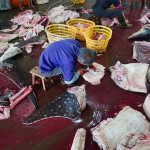
By now, you’ve probably seen coverage of the news from July 24 by MSNBC, and documented first-hand by my colleague John Bruno over at SeaMonster (What a marine massacre looks like), of the capture of a fishing vessel that was found illegally fishing sharks within the protected waters of the Galápagos Marine Reserve. The Galapagos National Park put out a press release regarding the incident as well.
As John briefly summarizes in words (using pictures to convey the real punch), he and his research team were assisted by the Ecuadorian Coast Guard to identify, sex, and measure each of the 379 sharks found on board. John sums-up the grisly work he and his field team were called-upon to perform,
“…it was one of the most depressing and intense days of my life. It felt like we were unearthing a mass grave in a war zone. The bodies of the sharks were literally coming out of a dark hold beneath the deck as if they were being unearthed.”
After a 10-hour effort to fully document the catch, the shark fins and carcasses (representing several near-shore and open-water species) were dumped overboard in front of three of the 30 fishermen who were arrested aboard the vessel.
I can’t imagine grinding through the long hours it took John’s team to process and document the catch. For a group of ocean scientists–so acutely aware of the precarious position global shark populations are facing from overfishing–the sight, smell, and reality of discovering this illegal haul in none other than the Galápagos Marine Reserve, one of the world’s most well-known marine protected areas, must have been jolting.
Imagine visiting the Louvre Museum to find the Italian Renaissance wing nearly empty of her collections and the museum toilets stocked with swatches from de Vinci’s Mona Lisa, Raphael’s St. Michael Slaying the Devil, and Mantegna’s St. Sebastian as toilet paper. I suppose that’s a fair analogy for what John’s team found aboard the captured vessel.
As heart-wrenching as this news from the Galápagos may be, I’m finding it difficult to muster shock and outrage on par with what I’m reading in some of the comments sections where this story first appeared. One SeaMonster reader comments, “It is very difficult to understand why anyone could do such a horrible thing.” Another asks, “Isn’t Sea Shepherd meant to be protecting the sharks of the Galápagos? This is why I donated to them in the first place what the hell is going on?” And amidst the many and varied trolling on display at MSNBC, comments seem to reverberate around demonizing the fishermen and how something like this could happen,
“It would have been appropriate to cut the arms off the criminals and toss them into the sea, along with their victims!”
“…how can these things just keep happening?”
“These idiots do not realize the untold damage to the system every species has its place in the balance of Nature How long can this go on before Disaster strikes There should be Life Imprisonment for these lowlifes.” [sic]
The truly unfortunate fact is that this news is neither new nor uncommon. And it is global.
Designation of any parcel of ocean “as protected”, formally or informally, is no guarantee of protection. The Galápagos National Park became a World Heritage site by the United Nations Educational, Scientific, and Cultural Organization (UNESCO) in 1978. In 1986, Ecuador established the Galápagos Marine Reserve, encompassing the 27,000 square miles of ocean surrounding the Galápagos Islands.
But the noble aims of the World Heritage status and marine reserve designation have proved more slippery and elusive than anyone imagined. Calling something protected is not the same as actively ensuring that protection is happening.
Many of the legal protections established for the Galápagos Marine Reserve exist on paper only—powerful competing interests often thwart their enforcement. The archipelago’s marine bounty has attracted poachers who are not deterred by the area’s protected status. Mainland and foreign fishing interests illegally target marine life within the reserve, going after sharks (for their fins) and sea cucumbers.
The National Park staff is occupied with monitoring tourists, who are appearing in increasing numbers, drawn by photographs showing the islands’ stark beauty and by reports of the curiously docile wildlife with whom close yet relatively safe encounters are possible. Since 1991 the number of visitors has soared from 41,000 a year to more than 160,000. The local population has grown by four percent every year and now numbers more than 40,000. Human visitors over the centuries have brought invasive species with them, most significantly goats, dogs and rats, which have depleted or made extinct a number of endemic plant and animal species.
Conservation efforts have been so eroded by these threats that in 2007 UNESCO designated the Galápagos Islands a World Heritage Site in Danger. The islands continue to be in need of help. In 2007, the Sea Shepherd Conservation Society stepped in to fill that void and assist the Ecuadorian Environmental Police in busting a major shark-fin cartel based on the Ecuador mainland. Sea Shepherd also partnered with the Galápagos National Park to hound poachers within the Marine Reserve and confiscate or destroy their gear and vessels. However, Sea Shepherd’s direct-action activities ground to a halt in 2008 when their vessel fell into disrepair. Even after an overhaul, the ship has no crew and (to my knowledge) remains anchored in the harbor on Santa Cruz Island.
So while we appear to be getting better at establishing legislative protection for sharks, where the rubber hits the road is in the enforcement of that protection. And enforcement takes funding, training, monitoring, consequences, public awareness, and a judicial process prepared to prosecute. Expecting open water to somehow police itself is as realistic as expecting a bank to safeguard its holdings without surveillance, guards, and a prosecutorial system.
And what about those fishermen? Don’t they know better? Elimination of sharks can have unpredictable and potentially disastrous effects further down the marine food chain. What happened to informed self-interest?
You and I get that fishing a low fecundity, slow growth, slow to reproductive maturity, supply limited species is a formula for ecological and economic ruin. But what are the options? What will fill the revenue void for fishers if all shark finning was banned globally tomorrow? What sustainable fisheries trainings are being offered? And if no sustainable fishing alternatives are available, what alternative livelihoods are nations prepared to present? However stomach-churning the reality, waste, and short-sightedness of shark finning may be, I refuse to believe that all fishers engaged in the process are mindless savages bent on pursuing personal fortune. Perhaps some of them know what they are engaged in is an utterly unsustainable enterprise. But again, what does their option and opportunity landscape look like?
I don’t have answers to these queries. And I am NOT presenting an argument for shark fisheries. The nature of most pelagic and in-shore species simply does not present compelling evidence for sustainable harvest. And what evidence that exists is pretty thin. But I have met some of these shark fishers in the field and they don’t match their demonized characterization. I recently encountered news from the field of a village that was trading a bag of dried shark fins harvested from reef sharks just offshore (with a conservative market value of US$1000) for a sack of granulated sugar (approximately worth US$150-$200). These villagers are not monsters. They’re people living near subsistence lives who lack the context of, and appreciation for, the value of living sharks on their reefs.
But while the arc of history of our ability to adequately manage ocean resources is long, it’s [slowly] bending towards justice.
Perhaps my favorite comment on the grim news from the Galápagos came from Scott Henderson, a shark expert and director of Conservation International’s Eastern Tropical Pacific Seascape program. In a blog post he wrote, Henderson chose to frame the Galapagos incident in a rather less depressing light,
“What is newsworthy about this story is that targeted shark fishing is illegal in Ecuador, and all kinds of shark capture in Galápagos are forbidden. Yet despite their limited resources, the Galápagos National Park Service — with the staunch support of the Ecuadorian Navy — managed to chase down a relatively large commercial fishing vessel with a medium-sized speedboat and force the vessel back to port for a thorough, well-documented and transparently reported inspection and judicial process.
The pressures on the park service to turn a blind eye to such illegal activities and let vessels involved in them slip away undetected, or unapprehended, are immense. Yet a transformation has occurred in Galápagos; protecting sharks, not sitting idly by and watching them systematically eliminated, is now business as usual for both the park and the navy. Virtually no one recognizes the park service for this dedication, which in the past has led to gunshots and wounded park guards.”
While recognizing his assessment doesn’t offer a way forward in assisting fishers in sustainable livelihoods, we can still take Henderson’s words at face value and see this sad Galápagos tale transformed into promising news for increased enforcement capacity. Here’s hoping that future enforcement stories aren’t accompanied by such a disturbing post mortem.






I think it is good news that such a vessel was actually stopped. But what I find far more interesting is how the fishermen are prosecuted, and whether this results in any larger investigation. I’ve previously researched that fines for poaching are quite low relative to the potential gain. Worse, the poachers are typically just the poor henchmen; they get the trouble while the financial backers sit pretty elsewhere.
What is missing here, and is crucial, is who owned the large fishing vessel and what flag was it flying?
The quote about Sea Shepherd is daft; what does the writer expect for his/her ten dollars or whatever? It’s good that some NGO is willing to put itsvery limited resources to such use. SJH
This is just business as usual in Ecuador. Mark’s comment on the financial backers is quite valid. Based on what I have seen, you would probably find them doing lunch with UNESCO??
This begs another question about how to stop the endemic and chronic corruption and inept governance in Ecuador?
Well written sir, great summary. I pushed this out to our 25k today.
http://sharkdivers.blogspot.com/2011/07/contextualize-your-outrage-well-said.html
Thanks for the kind words, Patrick (and spreading the word!).
I think this is good news as well, Mark, about the capture of the vessel AND the international attention it can receive from any prosecution. But it’s hard to know what sort of fines (if any) will be levied. The history of punishment has been uneven. Take the 2009 case of the Atlanta, GA, sharkfin “kingpin” Mark L. Harrison who was ordered to perform 150 hours of community service, sentenced to pay a fine of $5,000, and placed on probation for five years. That must have been rough. But then you have the 2007 case of a Taiwan-based fishing boat captain who had to pay a civil penalty of US$160,000, $20,000 in cost recovery to Palau‘s Marine Enforcement Bureau, forfeiture of $5,643 in fish sales and forfeiture of his fishing equipment of hooks, lines and leaders after being caught with 650 shark fins, 94 shark bodies and ten shark heads. He has also received an additional $1000 fine for an attempted cash bribe he offered to a law enforcement officer.
But are the fines reaching the true level of accountability, the ship owners? Or the bulk purchasers of shark fin? And how far up the supply chain should (could) fines travel?
The Sea Shepherd Conservation Society has been involved with protecting the Galapagos since 2000. Our patrol vessel Sirenian is not in disrepair. We donated it to the National Park and it’s engines were since sabotaged. We no longer have control over it to repair it. But we have provided the police with radios and a trained canine unit to sniff out smuggled shark fins and sea cucumbers. We have installed an AIS system to monitor illegal activity in the marine reserve. We have provided legal assistance to the National Park. We have provided engineers to maintian the surveillance barge at Wolf and Darwin. We have investigated and worked with the police to arrest numerous poachers and to shut down numerous poaching operations. Overall we have contributed to the lessening of criminal activty in the Galapagos but it is a daunting task with one step forward and two steps backwards. Poaching remains a serious threat and eco-tourism an even more serious threat. The Galapagos are being destroyed by both poachers and eco-tourism. For further information on Sea Shepherd activities in the Galapagos: http://www.seashepherd.org
As always sir, been a big fan of you folks for a while.
Sadly, passing and even enforcing laws banning shark finning is only half the battle, and on balance it’s sadly the less effective half. And don’t get me wrong, strong legislation to protect sharks is vital. But alone, these laws have an unfortunate side-effect: They constrain supply (which is a good thing) but fail to curb demand. The net result is that for fishermen, shark finning becomes a more dangerous activity, however it also becomes vastly more rewarding because it raises the prices for shark fins.
Legislation and enforcement must be combined with activism aimed at reducing the demand for Shark fins. This means public education wherever Shark Fin soup remains a popular item. We’re beginning to see some progress in this area, it seems the younger generations in China and of Chinese-Americans in the U.S. is increasingly aware of the real ecological cost of shark fin soup, but unfortunately not yet at a rate that impacts demand.
Laws like Hawaii’s zero-tolerance policy towards shark fins of any sort serve as a great middle ground, but that sort of law is currently impossible to pass in China. We need to focus our efforts at educating shark fin consumers and do whatever we can to make the consumption of shark fins as socially repellent as the ivory trade. Only then can we get to the economic tipping point necessary to save sharks.
Right now, shark finning is relatively safe and economically rewarding. Effective legislation makes shark finning dangerous, but substantially more lucrative. Legislation plus awareness on the consumer side is the golden formula: Shark finning becomes more dangerous and far less lucrative. That’s where we need to get.
Agreed, Mark, that legislative protection and enforcement are absolutely essential elements for shark conservation, but by no means are they (in and of themselves) silver bullets. Social marketing, outreach and awareness, and good old fashion shaming are some of the necessary tools we need to unpack as well. I think my friend and colleague Claudia Li at Shark Truth is doing incredible work with new generations in China and North America to change social norms and expectations around shark fins. And WildAid has produced some very creative PSAs with celebrities like Yao Ming to help change attitudes and perceptions. But you’re right, as long as demand persists, supply will find a means to flow. It’s unlikely (in fact it’s probably unrealistic) that the demand and supply will ever completely shut off. It’s hard to police a planet. But through the creation of shark sanctuaries, providing adequate enforcement, breaking the supply chains or trans-oceanic shipping loopholes, and outreach and awareness campaigns, we can strive to dramatically reduce the demand sufficiently to give shark populations the breathing room necessary to recover.
The catch should have been sold–not dumped–and the proceeds used to finance anti-poaching measures. Same thing with poached elephant tusks. Burning them just increases the price on all the remaining ivory in existence.
Even if revenue might be generated from the sale of the shark fins or meat with the intention of donating profit to conservation, I’d have little confidence of the money reaching the places for which it was intended.
In Wasser et al 2010, the question was asked whether legal sale of ivory collected from poachers influences levels of poaching across Africa. The answer was that this could not be resolved, partly because MIKE (Monitoring Illegal Killing of Elephants), created by CITES in 1997 to assess poaching rates on a continental scale, is unable to deliver data relevant to causality. One might think that putting confiscated ivory up for sale might have, at least, taken some pressure off wild populations for a certain period. But this has not been empirically demonstrated.
I think the burning of ivory or the destruction (dumping or burning) of charismatic species such as sharks is a shocking thing to see and read about and may raise the general public’s awareness of the plight of elephants, sharks, tigers (whatever) and the reality of poaching. This ”grand gesture” might awaken people to action who otherwise had no idea of the gravity of the problem.
That’s my perspective.
In general, revenue streams created from the sale of confiscated contraband legitimize the product and propagate a demand, which results in more poaching.